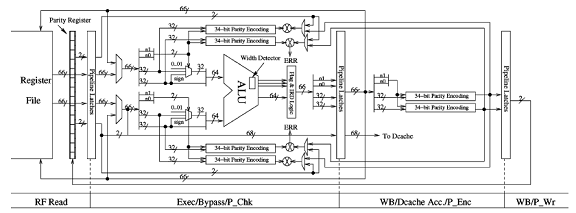





Published on Nov 30, 2023
Protecting the register value and its data buses is crucial to reliable computing in high-performance microprocessors due to the increasing susceptibility of CMOS circuitry to soft errors induced by high-energy particle strikes.
Since the register file is in the critical path of the processor pipeline, any reliable design that increases either the pressure on the register file or the register file access latency is not desirable.
In this paper, we propose to exploit narrow-width register values, which present the majority of the generated values, for making a duplicate of the value within the same data item; this in-register duplication (IRD) eliminates the requirement for additional copy registers.
The data path pipeline is augmented to efficiently incorporate parity encoding and parity checking such that error recovery is seamlessly supported in IRD and the parity checking is overlapped with the execution stage to avoid increasing the critical path.
A detailed architectural vulnerability factor (AVF) analysis shows that IRD significantly reduces the AVF from 8.4% in a conventional unprotected register file to 0.1% in an IRD register file. Our experimental evaluation using the SPEC CINT2000 benchmark suite also shows that IRD provides superior read-with-duplicate (RWD) and error detection/recovery rates under heavy error injection as compared to previous reliability schemes, while only incurring a small power overhead

We propose to exploit the produced narrow-width register values for designing high-performance error-resilient register files, and protecting the result write-back bus and the bypass network.
In the proposed new processor micro-architecture, the existing leading-0/1 detection logic within the functional units is utilized for narrow-width check
VHDL
Simulation: modelsim5.8c
Synthesis: Xilinx 9.1